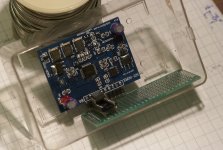I bought a Weilang XMOS card - 10 pins version that outputs I2S - to integrate is a TDA1543 DAC.
But I have some serious problems. The left channel is up and running, but the right is a square wave at best or a noisy popping signal.
I attached XMOS card to DAC as follows:
No attennuators.
As a test of the correct working I used a CAT6 interface between the Weilang XMOS and the DAC card; while I also had a CD player with an I2S output (grabbed from TDA1541 legs 1,2,3. With the input from the player all is OK; reverting to the XMOS card I have problems again. I inserted an ethernet male and female plug in between.
I used two DAC cards, both show the same problems with the I2S from the XMOS card.
Please, do you have any suggestions?
here are some funny pictures and these are not intended as art . 🙁
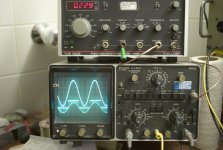
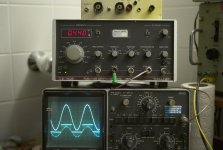
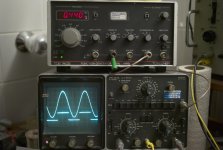

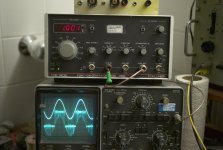
while this the result for these same chips to the CD player:

hope to get some insights!
albert
But I have some serious problems. The left channel is up and running, but the right is a square wave at best or a noisy popping signal.
- Strange enough the output distortion differs per chip - I tested various chips on the DAC boards.
I attached XMOS card to DAC as follows:
pin 9, BCK --> pin 1 BCK input;
pin 8 DATA --> pin 3 DTA input
pin 7 LRCK --> pin 2 WS input
pin 8 DATA --> pin 3 DTA input
pin 7 LRCK --> pin 2 WS input
No attennuators.
As a test of the correct working I used a CAT6 interface between the Weilang XMOS and the DAC card; while I also had a CD player with an I2S output (grabbed from TDA1541 legs 1,2,3. With the input from the player all is OK; reverting to the XMOS card I have problems again. I inserted an ethernet male and female plug in between.
I used two DAC cards, both show the same problems with the I2S from the XMOS card.
Please, do you have any suggestions?
here are some funny pictures and these are not intended as art . 🙁





while this the result for these same chips to the CD player:

hope to get some insights!
albert
I solved it!
I solved this mystery, by setting the MIDI interface (in MacOS) to 88.2 KHz.😀
Now both channels are up and running!
I will have a look how to force 176 KHz though, might be that there is some attenuation needed of a signal. The XMOS for instance outputs has a quite lower impedance than the SAA7220 for instance, with clear rise time and square waves.
I solved this mystery, by setting the MIDI interface (in MacOS) to 88.2 KHz.😀
Now both channels are up and running!
I will have a look how to force 176 KHz though, might be that there is some attenuation needed of a signal. The XMOS for instance outputs has a quite lower impedance than the SAA7220 for instance, with clear rise time and square waves.
- It is a clear square wave, and the old Philips chip does not excel there.
- The counterside might be some internal bounce (too fast rise time what might impact the second channel starting).
- Status
- Not open for further replies.
